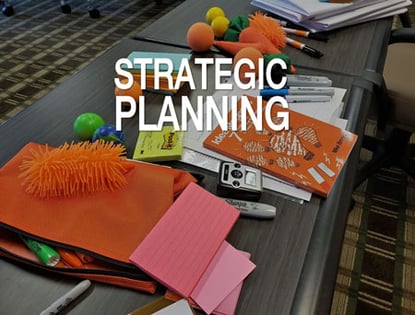A topic among my Friday lunch partners was whether a blog post would emerge from our conversation about strategic planning and creating strategic impact.
They were pretty sure one would, and they were right.
 We were discussing strategic planning challenges within a matrix organization. Issues emerge when multiple groups with line responsibilities (i.e., product lines, business units, geographic units, etc.) need to coordinate separate planning activities.
We were discussing strategic planning challenges within a matrix organization. Issues emerge when multiple groups with line responsibilities (i.e., product lines, business units, geographic units, etc.) need to coordinate separate planning activities.
Ideally, one group goes first and the other follows to coordinate their strategic plans. This requires more time, however, since groups are planning one after the other instead of concurrently.
Additionally, if actual planning falls behind, the departments supporting the line organization that also need to plan and prepare for line organization activities are even further behind.
Another alternative is for the two line groups to plan at the same time. That can result, however, in plans that do not fit together well, expect more resources than are available, or simply are not in sync strategically. Typically then, it falls on support organizations (i.e., marketing or finance) to try reconciling the discrepancies that surface.
3 Strategic Planning Ideas in a Matrix Organization
What are potential approaches in a matrix organization to both increase strategic planning coordination and minimize how long planning takes?
Here are three strategic planning ideas The Brainzooming Group tries to implement in these matrix organization situations:
1. Create meaningful strategic conversations between line units
While line units may be talking throughout the planning process, that talking is likely NOT speeding up planning appreciably. Facilitating meaningful strategic conversations gets them discussing issues that will provide the insights each unit needs to better coordinate its plan with others for the coming year.
2. Provide early, simple strategic planning deliverables to signal strategic directions
Important strategic decisions are discussed and made well before the final strategic plan is written. There is no reason these decisions should be new news when the plan document is done. Creating interim planning deliverables that are simple to complete and designed to be shared before the plan is done can boost important strategic coordination.
3. Concentrate on big plan differences
Much of what goes into a strategic plan seems important. Incremental changes in plans from one year to another, however, likely have little material impact on the decisions and plans of other units in the organization. As a result, if separate parts of a larger organization can share their major strategic plan changes earlier, much of the incremental detail is fine to be shared later.
Turning Strategic Planning into Creating Strategic Impact
Getting ahead of the typical strategic planning cycle allows you to refine, simplify, and shorten planning and place more emphasis on creating strategic impact.
Are you thinking about what needs to happen with your next plan?
If you are not sure which strategic planning direction is best, let us know you would like to talk about the topic. We have lots of ideas for making strategic planning better! – Mike Brown
If you enjoyed this article, subscribe to the free Brainzooming email updates.
The Brainzooming Group helps make smart organizations more successful by rapidly expanding their strategic options and creating innovative plans they can efficiently implement. Email us at info@brainzooming.com or call us at 816-509-5320 to learn how we can help you enhance your strategy and implementation efforts.




